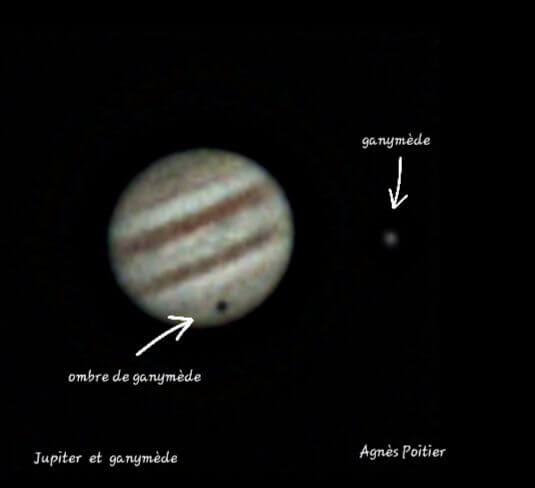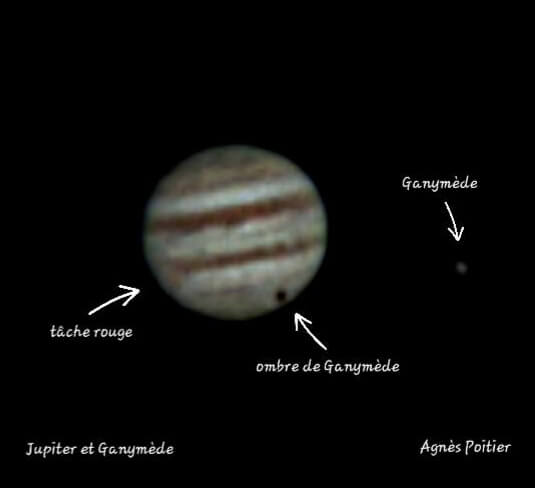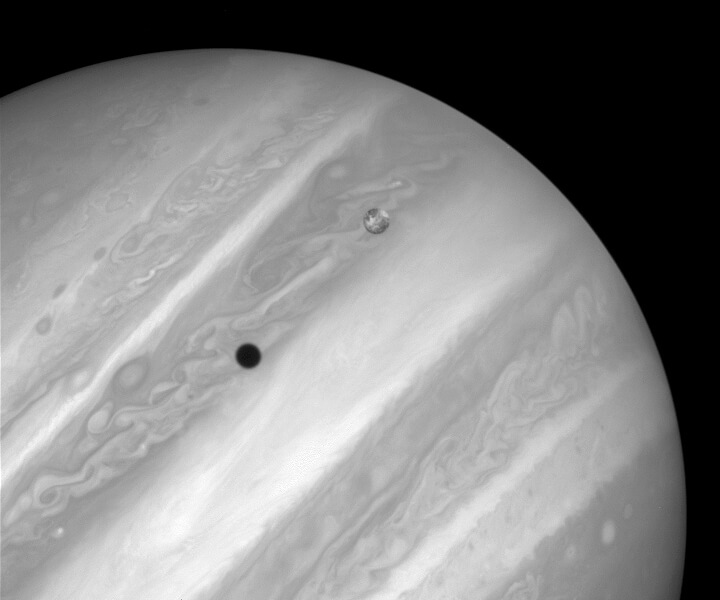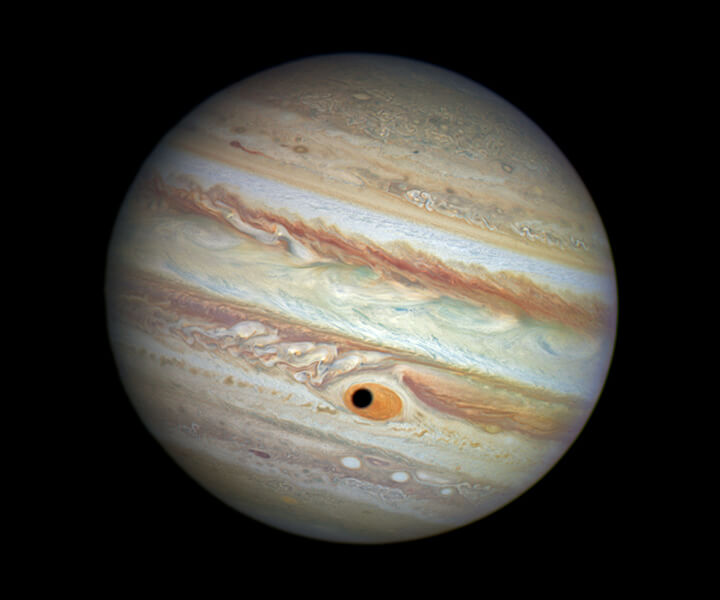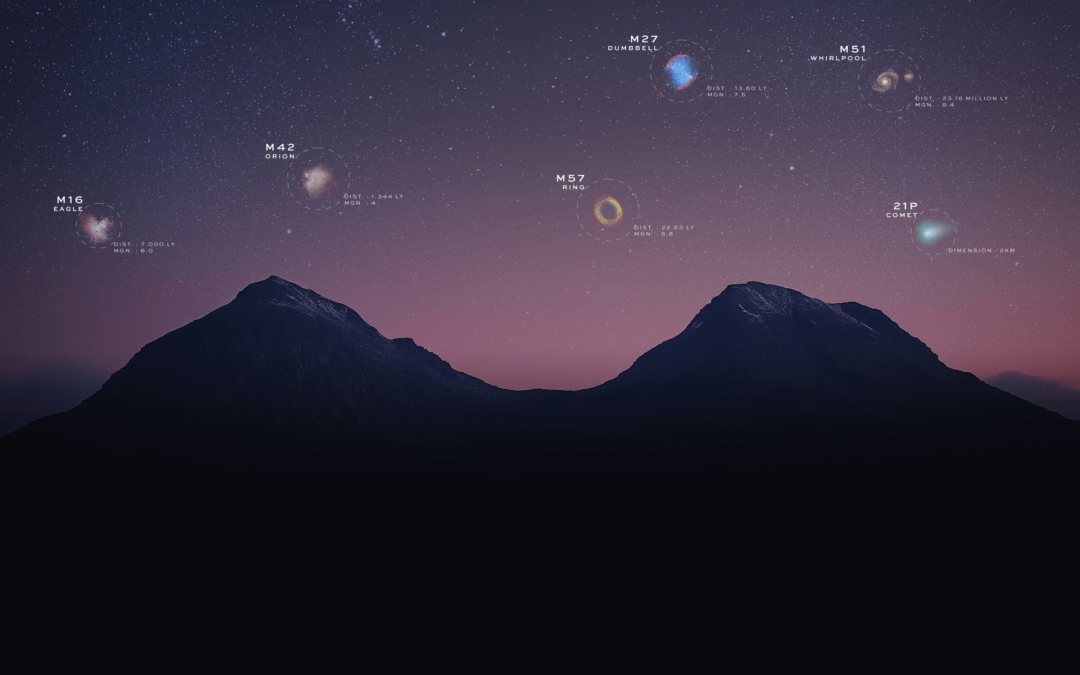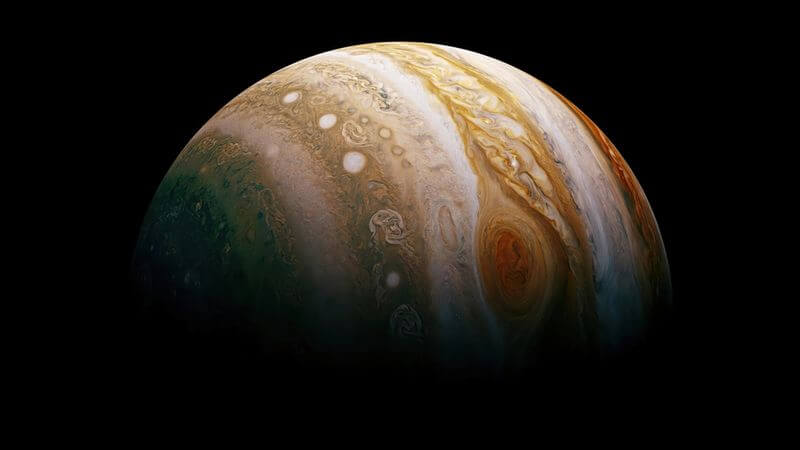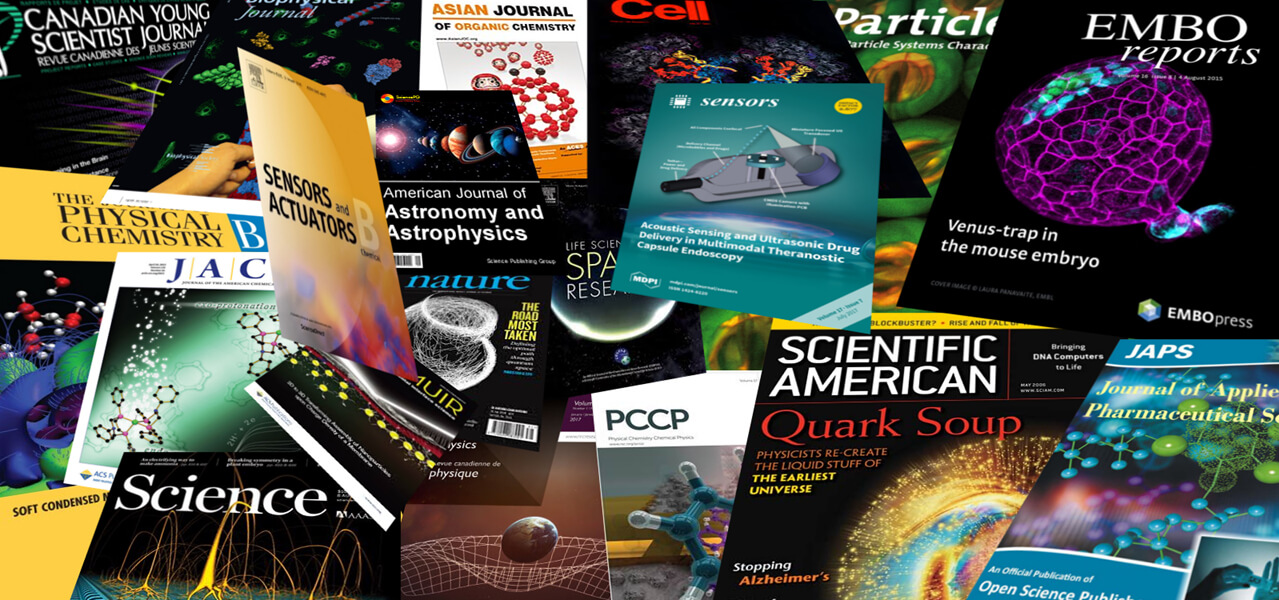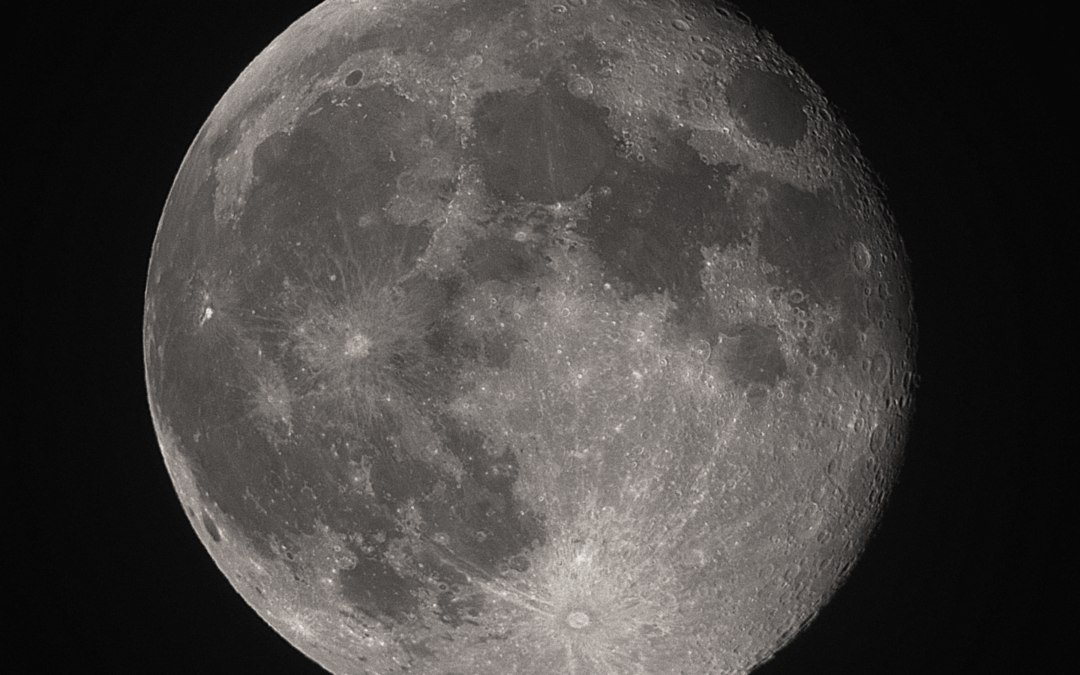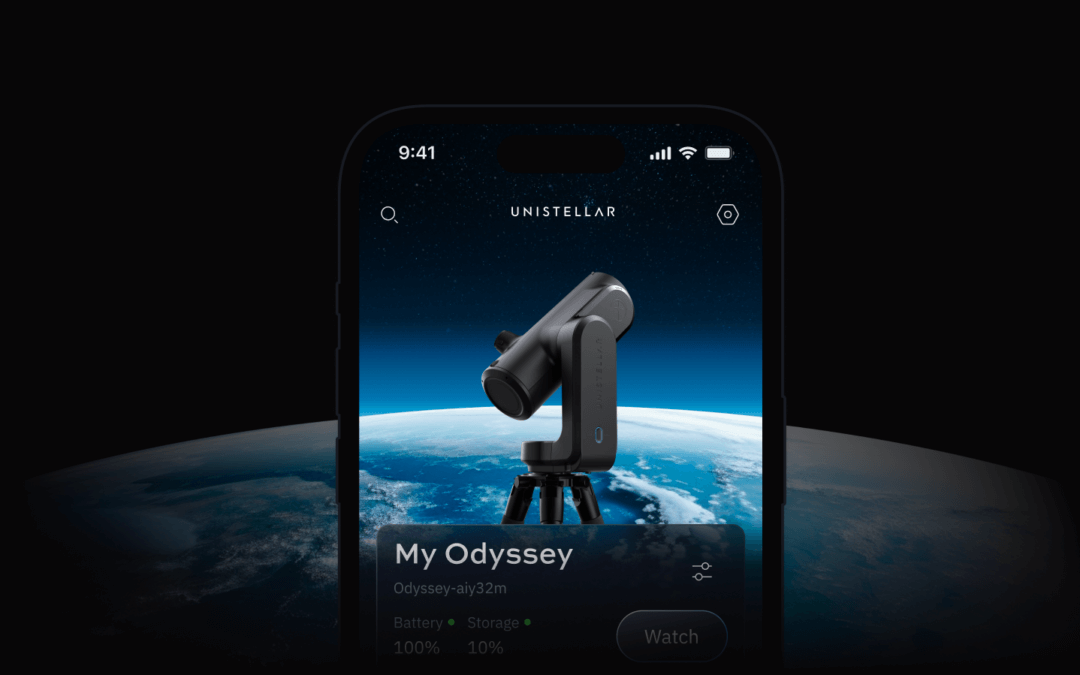A Ballet of Shadows on Jupiter
Solar eclipses on Earth are spectacular events that captivate millions of people. But did you know that similar eclipses regularly occur on Jupiter and can be observed with a telescope? These events, caused by the shadows of its main moons cast onto its surface, offer a unique opportunity to witness this dynamic planetary system in motion.
A true dance of shadows and light unfolds on the largest planet in the solar system, occurring regularly as the Galilean moons—Io, Europa, and Ganymede—project their shadows onto Jupiter’s swirling clouds. With a smart telescope of at least 80mm in diameter, you can not only observe these events in real-time but also capture stunning photos of these rare celestial moments.
Solar eclipse by Ganymede on Jupiter on January 13, 2025 at 8:30pm CET and 9:15pm CET (images taken by Agnès Poitier with a UNISTELLAR Odyssey Pro)
By J. Spencer (Lowell Observatory), and NASA/ESA – http://www.spacetelescope.org/images/opo9630a/ (direct link)http://hubblesite.org/newscenter/archive/releases/1996/30/image/a, Public Domain, https://commons.wikimedia.org/w/index.php?curid=1527339
A Remarkable Orbital Resonance
One fascinating phenomenon in the Jovian system is the orbital resonance between its three closest moons. For every eclipse caused by Ganymede, there are two eclipses from Europa and four from Io. This illustrates the 1:2:4 resonance between these moons. This resonance is the result of gravitational interactions between them, which have synchronized their orbits over time.
Agenda of eclipses in the USA (San Francisco)
|
Satellite |
Date |
Beginning (PT) |
End (PT) |
Remark |
|
Io |
Mar 2, 2025 |
00:32 |
02:44 |
Jupiter low above western horizon (sets at 1:24) |
|
Io |
Mar 4, 2025 |
19:01 |
21:13 |
|
|
Io |
Mar 11, 2025 |
21:56 |
00:08 |
|
|
Europa |
Mar 12, 2025 |
19:10 |
21:46 |
Starts before dark (sun sets at 19:11) |
|
Ganymede |
Mar 12, 2025 |
19:36 |
22:03 |
Starts before dark (sun sets at 19:11) |
|
Io |
Mar 18, 2025 |
23:52 |
02:04 |
Jupiter low above western horizon (sets at 1:29) |
|
Europa |
Mar 19, 2025 |
21:45 |
00:22 |
|
|
Ganymede |
Mar 19, 2025 |
23:37 |
02:05 |
Jupiter low above western horizon (sets at 1:26) |
|
Io |
Mar 20, 2025 |
18:21 |
20:21 |
Starts before dark (sun sets at 19:18) |
|
Io |
Mar 27, 2025 |
20:16 |
22:29 |
|
|
Io |
Apr 3, 2025 |
22:12 |
00:25 |
Jupiter low above western horizon (sets at 00:37) |
|
Europa |
Apr 13, 2025 |
18:49 |
21:27 |
Starts before dark (sun sets at 19:39) |
|
Io |
Apr 19, 2025 |
20:32 |
22:45 |
|
|
Europa |
Apr 20, 2025 |
21:24 |
00:03 |
Jupiter low above western horizon (sets at 23:44) |
|
Ganymede |
Apr 24, 2025 |
19:39 |
22:15 |
Starts before dark (sun sets at 19:49) |
|
Io |
Apr 26, 2025 |
22:28 |
00:41 |
Jupiter low above western horizon (sets at 23:26) |
|
Io |
May 5, 2025 |
18:52 |
21:05 |
Starts before dark (sun sets at 19:59) |
|
Io |
May 12, 2025 |
20:47 |
23:01 |
Jupiter low above western horizon (sets at 22:38) |
|
Europa |
May 15, 2025 |
18:28 |
21:08 |
Starts before dark (sun sets at 20:07) |
|
Europa |
May 22 2025 |
21:03 |
23:44 |
Jupiter low above western horizon (sets at 22:08) |
Agenda of eclipses in Europe (Paris)
|
Satellite |
Date |
Beginning (CET) |
End (CET) |
Remark |
|
Ganymede |
Mar 4, 2025 |
23:35 |
02:01 |
Jupiter low above western horizon (sets at 2:41) |
|
Europa |
Mar 4, 2025 |
00:35 |
03:10 |
Jupiter low above western horizon (sets at 2:41) |
|
Io |
Mar 5, 2025 |
22:29 |
00:41 |
|
|
Io |
Mar 13, 2025 |
00:25 |
02:37 |
Jupiter low above western horizon (sets at 02:14) |
|
Io |
Mar 14, 2025 |
18:54 |
21:06 |
Starts before dark (sun sets at 18:53) |
|
Io |
Mar 21, 2025 |
20:50 |
23:02 |
|
|
Europa |
Mar 22, 2025 |
19:03 |
21:40 |
Starts before dark (sun sets at 19:05) |
|
Io |
Mar 28, 2025 |
22:45 |
00:58 |
|
|
Europa |
Mar 29, 2025 |
21:38 |
00:15 |
|
|
Io |
Apr 6, 2025 |
20:10 |
22:23 |
Starts before dark (sun sets at 20:28) |
|
Ganymede |
Apr 9, 2025 |
20:39 |
23:12 |
Starts before dark (sun sets at 20:32) |
|
Io |
Apr 13, 2025 |
22:05 |
00:18 |
|
|
Ganymede |
Apr 17, 2025 |
00:39 |
03:14 |
Jupiter low above western horizon (sets at 01:19) |
|
Io |
Apr 21, 2025 |
00:01 |
02:14 |
Jupiter low above western horizon (sets at 01:07) |
|
Europa |
Apr 23, 2025 |
19:42 |
22:21 |
Starts before dark (sun sets at 20:53) |
|
Io |
Apr 29, 2025 |
20:25 |
22:39 |
Starts before dark (sun sets at 21:02) |
|
Europa |
Apr 30, 2025 |
22:17 |
00:57 |
|
|
Io |
May 6, 2025 |
22:21 |
00:34 |
Jupiter low above western horizon (sets at 00:19) |
|
Io |
May 22, 2025 |
20:40 |
22:54 |
Starts before dark (sun sets at 21:33) |
|
Ganymede |
May 22, 2025 |
20:41 |
23:22 |
Starts before dark (sun sets at 21:33) |
Understanding Eclipses on Jupiter
Just like solar eclipses on Earth occur when the Moon passes between us and the Sun, eclipses on Jupiter happen when one of its moons moves in front of the Sun and casts its shadow onto the planet’s surface.
Jupiter has over 90 moons, but the four largest, known as the Galilean moons (Io, Europa, Ganymede, and Callisto), are the most likely to create spectacular eclipses. These moons, discovered by Galileo in 1610, orbit relatively close to the planet and cast sharp, well-defined shadows that can be observed from Earth.
For an observer on Jupiter, these moons appear larger than the Sun in the sky. As a result, the area experiencing a total solar eclipse is much larger than the area where the eclipse is only partial. Seen from Earth, this creates a very distinct shadow on the planet’s surface.
These eclipses occur regularly due to the precise orbits of the Galilean moons. For instance, Io, the closest moon to Jupiter, completes one orbit in just 1.8 Earth days, meaning its eclipses occur approximately every two days! Meanwhile, Ganymede, which is farther away, takes 7 days and 3 hours to complete one orbit, resulting in roughly one eclipse per week.
But why are eclipses on Earth so rare—only about six per decade—even though the Moon has a 28-day orbit? The reason lies in the imperfect alignment between the Earth, the Moon, and the Sun due to the inclination of their orbits. Additionally, because the Earth is much smaller than Jupiter, the Moon’s shadow often passes beside it rather than directly over it.
Similarly, Jupiter’s moons are not perfectly aligned with the Sun and the planet. However, Jupiter’s massive size increases the likelihood of an eclipse occurring, as its large disk is more likely to capture the shadow cast by its moons. That said, it is still rare for these eclipses to be visible precisely on Jupiter’s equator due to the same alignment variations.
Going Further: A Bit of Physics
Gravity follows a simple yet fascinating rule: the farther a satellite is from its planet, the slower it moves and the longer its orbital period. For example, as previously mentioned, Ganymede, which is farther from Jupiter than Io, moves more slowly. This rule is described by Kepler’s Third Law, which states that the square of a moon’s orbital period is proportional to the cube of its distance from the planet (T²/a³ = constant).
Discovered empirically by Johannes Kepler in 1619, this law applies to all planetary systems, including our own solar system. The constant in the equation varies depending on the mass of the central body. Later, in 1687, Isaac Newton demonstrated, using his law of gravitation, that this constant is given by 4π²/MG, where M is the mass of the central body and G is the universal gravitational constant.
|
Distance (km) |
Period (day) |
|
|
Io |
421,800 |
1.769 |
|
Europa |
671,100 |
3.551 |
|
Ganymede |
1,070,400 |
7.155 |
|
Callisto |
1,882,700 |
16.689 |
Further readings
3 Reasons to observe this month
Every month, discover three unmissable celestial events to observe with your Unistellar telescope.
Observing Eclipses on Jupiter: Cosmic Spectacles Through a Telescope
The latest Unistellar App Update, version V3.0, is now live. Explore a smooth stargazing experience !
Unistellar Community Included In Multiple Scientific Papers
Did you know Unistellar Citizen Astronomers are often cited in published scientific papers? Find out how you can contribute too!
What Are the Names of All the Full Moons in 2024?
Discover the enchanting names of the full moons in 2024. Delve into the unique character of each lunar spectacle and embrace the allure of the night sky.
New Unistellar App Update: Version 3.0
The latest Unistellar App Update, version V3.0, is now live. Explore a smooth stargazing experience !
What to Observe This November: Open Star Clusters and More
These Halloween deep-sky objects will add some light to those dark, spooky nights. Treats, tricks, and telescopes await!

